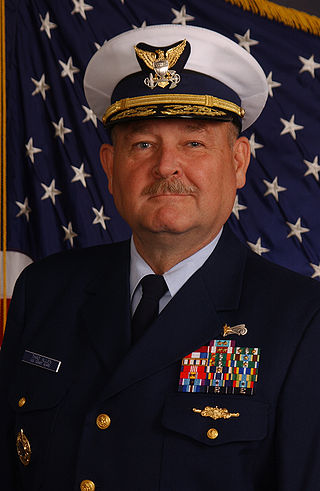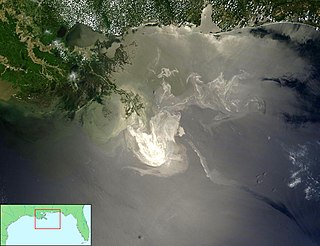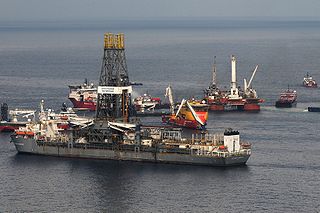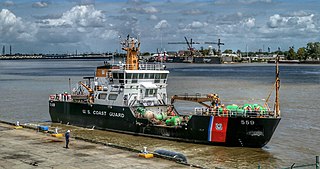
Thad William Allen is a former admiral of the United States Coast Guard who served as the 23rd commandant from 2006 to 2010. Allen is best known for his performance directing the federal response to hurricanes Katrina and Rita in the Gulf Coast region from September 2005 to January 2006, and for his role as National Incident Commander of the Unified Command for the Deepwater Horizon oil spill in the Gulf of Mexico in 2010. Robert J. Papp Jr. succeeded him as Commandant on 25 May 2010.

Deepwater Horizon was an ultra-deepwater, dynamically positioned, semi-submersible offshore drilling rig owned by Transocean and operated by BP. On 20 April 2010, while drilling at the Macondo Prospect, a blowout caused an explosion on the rig that killed 11 crewmen and ignited a fireball visible from 40 miles (64 km) away. The fire was inextinguishable and, two days later, on 22 April, the Horizon sank, leaving the well gushing at the seabed and causing the largest marine oil spill in history.

The Deepwater Horizon oil spill was an environmental disaster which began on April 20, 2010, off the coast of the United States in the Gulf of Mexico on the BP-operated Macondo Prospect, considered the largest marine oil spill in the history of the petroleum industry and estimated to be 8 to 31 percent larger in volume than the previous largest, the Ixtoc I oil spill, also in the Gulf of Mexico. Caused in the aftermath of a blowout and explosion on the Deepwater Horizon oil platform, the United States federal government estimated the total discharge at 4.9 MMbbl. After several failed efforts to contain the flow, the well was declared sealed on 19 September 2010. Reports in early 2012 indicated that the well site was still leaking. The Deepwater Horizon oil spill is regarded as one of the largest environmental disasters in world history.
The Macondo Prospect is an oil and gas prospect in the United States Exclusive Economic Zone of the Gulf of Mexico, off the coast of Louisiana. The prospect was the site of the Deepwater Horizon drilling rig explosion in April 2010 that led to a major oil spill in the region from the first exploration well, named itself MC252-1, which had been designed to investigate the existence of the prospect.

The Deepwater Horizon drilling rig explosion was an April 20, 2010 explosion and subsequent fire on the Deepwater Horizon semi-submersible mobile offshore drilling unit, which was owned and operated by Transocean and drilling for BP in the Macondo Prospect oil field about 40 miles (64 km) southeast off the Louisiana coast. The explosion and subsequent fire resulted in the sinking of the Deepwater Horizon and the deaths of 11 workers; 17 others were injured. The same blowout that caused the explosion also caused an oil well fire and a massive offshore oil spill in the Gulf of Mexico, considered the largest accidental marine oil spill in the world, and the largest environmental disaster in United States history.

The Bureau of Safety and Environmental Enforcement is an agency under the United States Department of the Interior. Established in 2011, BSEE is the lead agency in charge of improving safety and ensuring environmental protection relating to the offshore energy industry, mainly natural gas and oil, on the United States Outer Continental Shelf (OCS). The agency exercises the safety and environmental enforcement functions formerly under the Minerals Management Service including the authority to inspect, investigate, summon witnesses and produce evidence, levy penalties, cancel or suspend activities, and oversee safety, response, and removal preparedness.

The following is a timeline of the Deepwater Horizon oil spill. It was a massive oil spill in the Gulf of Mexico, the largest offshore spill in U.S. history. It was a result of the well blowout that began with the Deepwater Horizon drilling rig explosion on April 20, 2010.

James Angus Watson IV is a retired United States Coast Guard Rear Admiral. He currently serves as a senior vice president at the American Bureau of Shipping.

The Unified Command provides Incident Command System/Unified Command (ICS) for coordinating response to the Deepwater Horizon oil spill.

This article covers the effect of the Deepwater Horizon disaster and the resulting oil spill on global and national economies and the energy industry.
Following is a timeline of the Deepwater Horizon oil spill for June 2010.
Following is a timeline of the Deepwater Horizon oil spill for July 2010.

Cosmo Ace, formerly A Whale and Madison Orca, is a Liberian-flagged ore-oil carrier built in 2010 by Hyundai Heavy Industries, Ulsan, South Korea for TMT Co. Ltd. from the Republic of China (Taiwan). She has seven other sister ships in the fleet, built in 2010-2011 and named in succession: B Whale, C Whale etc., to H Whale.

Paul Frederick Zukunft is a retired admiral of the United States Coast Guard who served as the 25th commandant. He was confirmed by the U.S. Senate as the Commandant, with the rank of admiral, in May 2014 and relieved Robert J. Papp Jr. as commandant on 30 May 2014. Prior to his selection as Commandant, he served as Commander, Coast Guard Pacific Area. In this position, Zukunft was the operational commander for all U.S. Coast Guard missions within the half of the world that ranges from the Rocky Mountains to the waters off the East Coast of Africa. He concurrently served as Commander, Defense Force West and provided U.S. Coast Guard mission support to the U.S. Department of Defense and Combatant Commanders.

Sandra Leigh Stosz is a retired United States Coast Guard Vice Admiral whose final active duty assignment was as Deputy Commandant for Mission Support. Previously, she was chosen by the Commandant of the United States Coast Guard, ADM Robert J. Papp to become the superintendent of the United States Coast Guard Academy in 2011. As such, she is the first woman to lead a United States service academy. At the time of her appointment to head the Coast Guard Academy, she was the Coast Guard's director of Reserve and leadership. Stosz was confirmed as a vice admiral in May 2015.

Rear Admiral (ret.) Craig E. Bone is a former government executive under President George W. Bush, playing a key role in the forwarding of maritime domain awareness works, inter alia the container security initiative and implementation of the Maritime Transportation Security Act, as part of the wider Global Maritime Intelligence Integration Plan of this administration.
The Deepwater Horizon investigation included several investigations and commissions, among others reports by National Incident Commander Thad Allen, United States Coast Guard, National Commission on the BP Deepwater Horizon Oil Spill and Offshore Drilling, Bureau of Ocean Energy Management, Regulation and Enforcement, National Academy of Engineering, National Research Council, Government Accountability Office, National Oil Spill Commission, and Chemical Safety and Hazard Investigation Board.
The Deepwater Horizon oil spill was discovered on the afternoon of 22 April 2010 when a large oil slick began to spread at the former rig site. According to the Flow Rate Technical Group, the leak amounted to about 4.9 million barrels of oil, exceeding the 1989 Exxon Valdez oil spill as the largest ever to originate in U.S.-controlled waters and the 1979 Ixtoc I oil spill as the largest spill in the Gulf of Mexico. BP has challenged this calculation saying that it is overestimated as it includes over 810,000 barrels of oil which was collected before it could enter the Gulf waters.

Rear Admiral Meredith L. Austin is a retired United States Coast Guard officer who served as the Acting Deputy Assistant Secretary for Incident Command and Control within the Office of the Assistant Secretary Preparedness and Response (ASPR) since February 2020 to December 2020.

USCGC Barbara Mabrity (WLM-559) is a Keeper-class coastal buoy tender of the United States Coast Guard. Launched in 1999, she is home-ported in Mobile, Alabama. Her primary mission is maintaining aids to navigation from western Florida to the Mississippi River. Secondary missions include marine environmental protection, search and rescue, and security. She is assigned to the Eighth Coast Guard District.













